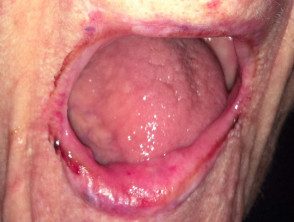What is it eosinophilic ulcer oral mucous membrane?
Eosinophilic ulcer of the oral mucosa is rare. benign Ulcer seen in middle-aged to older adults that appears suddenly in the mouth or lips is usually painful and heals within a few weeks. It may represent a nonspecific reaction pattern to trauma.
Eosinophils They are a type of inflammatory cell with a characteristic appearance under the microscope.
Eosinophilic ulcer of the oral mucosa is also known as traumatic ulcerative granuloma with stroma eosinophilia, oral traumatic granuloma, traumatic tongue granuloma or eosinophilic tongue ulcer. It is possibly the adult version of Riga-Fede disease.
Eosinophilic lip ulcer

Eosinophilic lip ulcer
Who gets eosinophilic ulcer of the oral mucosa and why?
Eosinophilic ulcer of the oral mucosa affects adults, with a peak in the sixth and seventh decades of life (50-80 years). There is a slight female predominance reported.
The cause of eosinophilic ulcer of the oral mucosa is unknown. Trauma is a reported trigger in 39%. The ulcer usually occurs at sites where trauma to the teeth is common and is seen in the age group most likely to have damaged teeth and dentures that can cause trauma. However, most simple traumatic ulcers in the mouth they do not show the clinical characteristics and histological characteristics of eosinophilic ulcer. Therefore, it has been suggested that trauma may allow as yet unidentified infections, toxins or foreign proteins to enter and trigger the characteristic inflammatory reaction in susceptible people. Another theory is that it represents a CD30+ lymphoproliferative disorder (a type of lymphoma)
What are the clinical characteristics of eosinophilic ulcer of the oral mucosa?
Typical clinical features of eosinophilic ulcer of the oral mucosa include:
- Rapid growth
- Painful: in most cases, but not all
- Solitary: multiple or recurrent injuries are reported but are rare
- Size range from a few mm to several cms.
- Base: white or yellow film that can be cleaned
- Edge: raised and firm
- Surrounding redness.
The most commonly affected site is the tongue, usually the sides or top.
Other reported locations (in descending order) are:
- inside the cheeks
- Between the gum and the cheek (mucobuccal fold)
- Lips (usually the lower lip)
- Dinner
- Palate
- floor of the mouth
- Behind the molar teeth.
The patient usually feels well, but eating and drinking may be limited by pain. Enlarged lymph nodes in the neck can be felt in rare cases.
Eosinophilic ulcer of the oral mucosa usually heals on its own within a month, but may persist for up to a year. Recurrences have rarely been reported.
Atypical Clinical presentations without ulcer have included:
- Flat red patches
- Erythroplakia
- Oral leukoplakia
- Firm swelling
How is the diagnosis of eosinophilic ulcer of the oral mucosa made?
A biopsy is usually required to confirm this diagnosis and exclude other conditions, such as aphthous ulcers and, most importantly, oral Cancer and infections.
the histology It is characteristic:
- Ulcerated mucous membrane surface
- Stunted granulomas
- Mixed inflammatory infiltrate that extends deep into the muscles and salivary glands
- Numerous eosinophils – showing degranulation
- Large atypical CD30+ T cells: occasional, scattered, may be monoclonal
- Greater amount of mast cells
- Degeneration and loss of muscle fibers.
Treatment of eosinophilic ulcer of the oral mucosa.
Eosinophilic ulcer of the oral mucosa usually heals on its own within a month, so no specific treatment is required. Rapid healing is usually seen after a biopsy. Analgesics may be required to relieve pain. Taking care of rough teeth or dentures can help with healing.
Reported treatments have included:
- Surgical excision
- Current corticosteroids – mouthwash, cream, intralesional injection, oral
- Antibiotics
- Simple curettage and diathermy
- Radiotherapy.
